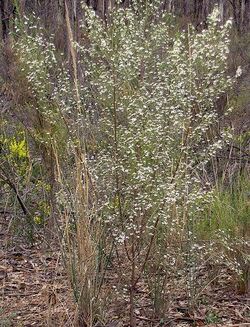Biology:Olearia teretifolia
| Olearia teretifolia | |
|---|---|

| |
| Scientific classification | |
| Kingdom: | Plantae |
| Clade: | Tracheophytes |
| Clade: | Angiosperms |
| Clade: | Eudicots |
| Clade: | Asterids |
| Order: | Asterales |
| Family: | Asteraceae |
| Genus: | Olearia |
| Species: | O. teretifolia
|
| Binomial name | |
| Olearia teretifolia (Sond.) Benth.[1]
| |
| Synonyms[1] | |
| |

Olearia teretifolia, commonly known as cypress daisy-bush,[2] is a species of flowering plant in the family Asteraceae and is endemic to south-eastern continental Australia. It is a slender, erect to spreading shrub with more or less sessile, linear leaves pressed against the stem, and white and yellow, daisy-like inflorescences.
Description
Olearia teretifolia is a slender, erect to spreading shrub that typically grows to a height of up to about 1.5 m (4 ft 11 in) and has glabrous, sticky branchlets and leaves. The leaves are arranged alternately, more or less sessile, 2–5 mm (0.079–0.197 in) long, about 0.5 mm (0.020 in) wide and usually pressed against the stem. The heads or daisy-like "flowers" are arranged singly on the ends of branches, often in large numbers, each head sessile and 10–16 mm (0.39–0.63 in) in diameter with an urn-shaped involucre 3–4 mm (0.12–0.16 in) long at the base. Each head has 4 to 10 white ray florets, the ligule 3.5–6 mm (0.14–0.24 in) long, surrounding 5 to 10 yellow disc florets. Flowering occurs from August to November and the fruit is a ribbed achene 1.0–1.5 mm (0.039–0.059 in) long, the pappus 2–3 mm (0.079–0.118 in) long.[2][3]
Taxonomy
This daisy was first formally described in 1853 by Otto Wilhelm Sonder who gave it the name Eurybia tertifolia in the journal Linnaea, based on plant material collected from the Mount Lofty Ranges.[4][5] It was renamed firstly as Aster teretifolius in 1865 by Victorian Government Botanist Ferdinand von Mueller in Fragmenta Phytographiae Australiae[6][7] and finally in 1867 by George Bentham as Olearia teretifolia in Flora Australiensis.[8][9] The specific epithet (teretifolia) means "terete-leaved".[10]
Distribution and habitat
Olearia teretifolia grows in forest, mallee and scrub in disjunct areas of Victoria and in the south-east of South Australia.[2][3]
References
- ↑ 1.0 1.1 "Olearia teretifolia". Australian Plant Census. https://biodiversity.org.au/nsl/services/apc-format/display/106957.
- ↑ 2.0 2.1 2.2 Walsh, Neville G.; Lander, Nicholas S.. "Olearia teretifolia". Royal Botanic Gardens Victoria. https://vicflora.rbg.vic.gov.au/flora/taxon/534c4205-20da-46ab-9893-fe2801224dc6.
- ↑ 3.0 3.1 "Olearia teretifolia". State Herbarium of South Australia. http://www.flora.sa.gov.au/cgi-bin/speciesfacts_display.cgi?form=speciesfacts&name=Olearia_teretifolia.
- ↑ "Eurybia teretifolia". https://biodiversity.org.au/nsl/services/rest/name/apni/532195/api/apni-format. Retrieved 20 August 2022.
- ↑ Sonder, Otto W. (1853). "Plantae Muellerianae. Beitrag zur Flora Sudaustraliens, aus den Sammlungen des Dr. Ferd. Muller.". Linnaea: Ein Journal für die Botanik in ihrem ganzen Umfange 25: 464–465. https://www.biodiversitylibrary.org/item/109556#page/470/mode/1up. Retrieved 20 August 2022.
- ↑ "Aster teretifolius". https://biodiversity.org.au/nsl/services/rest/name/apni/538240/api/apni-format. Retrieved 20 August 2022.
- ↑ von Mueller, Ferdinand (1865). Fragmenta Phytographiae Australiae. 5. Melbourne: Victorian Government Printer. p. 77. https://www.biodiversitylibrary.org/item/7222#page/85/mode/1up. Retrieved 21 August 2022.
- ↑ "Olearia teretifolia". https://biodiversity.org.au/nsl/services/rest/name/apni/537158/api/apni-format. Retrieved 20 August 2022.
- ↑ Bentham, George; von Mueller, Ferdinand (1867). Flora Australiensis. 3. London: Lovell Reeve & Co.. pp. 482–483. https://www.biodiversitylibrary.org/item/41807#page/490/mode/1up. Retrieved 21 August 2022.
- ↑ Sharr, Francis Aubi; George, Alex (2019). Western Australian Plant Names and Their Meanings (3rd ed.). Kardinya, WA: Four Gables Press. p. 322. ISBN 9780958034180.
Wikidata ☰ Q7086013 entry
 |

